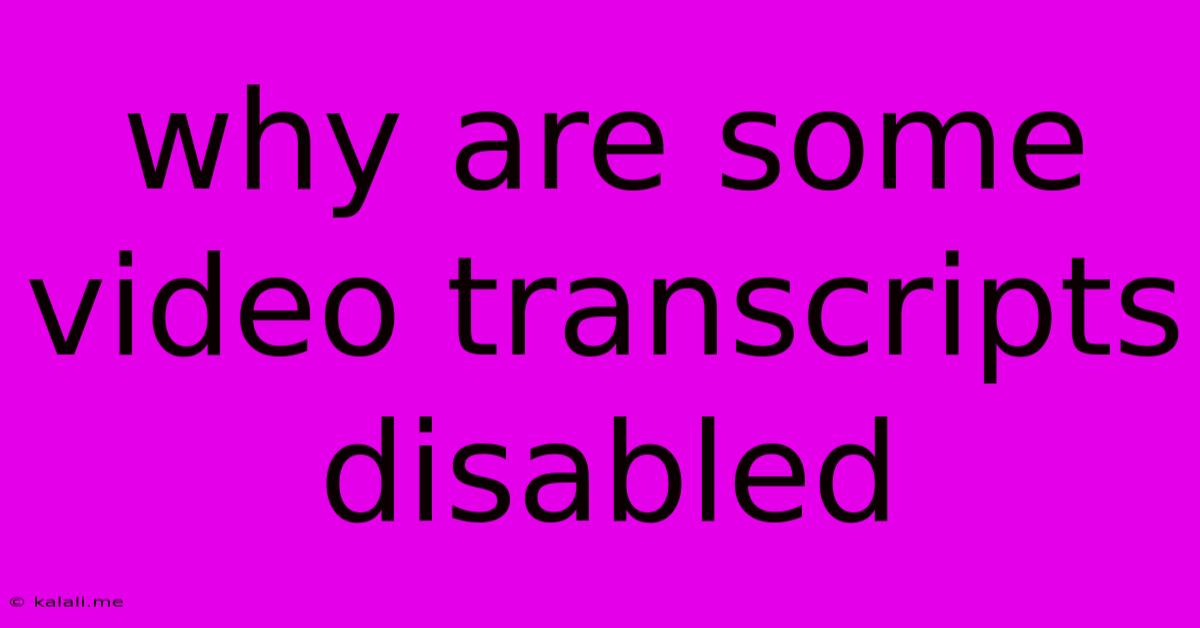Why Are Some Video Transcripts Disabled
Kalali
Jun 09, 2025 · 3 min read

Table of Contents
Why Are Some Video Transcripts Disabled? A Deep Dive into Accessibility and Copyright
Video transcripts are a crucial element for accessibility and SEO, yet some videos lack them entirely, while others have them disabled. This isn't just an oversight; there are several reasons why creators might choose to disable video transcripts, ranging from technical limitations to copyright concerns. Understanding these reasons is key to appreciating the nuances of online video content.
This article explores the various factors that contribute to disabled video transcripts, examining both the creator's perspective and the user's experience. We'll delve into the importance of accessibility, the role of automatic transcription services, and the complex issue of copyright infringement.
Technical Limitations and Transcription Accuracy
One of the most common reasons for disabled transcripts is the quality of the automatic transcription. Many platforms offer automatic transcription services, but these aren't always perfect. Poor audio quality, accents, background noise, and rapid speech can all lead to inaccurate transcripts that are more harmful than helpful. An inaccurate transcript can be confusing, frustrating, and even misleading for viewers. Creators often prefer to disable a flawed transcript rather than risk misrepresenting their content.
This issue highlights the challenge of balancing automation with accuracy. While automatic transcription significantly reduces the workload for creators, manual review and editing are often necessary to ensure high quality. This additional step, however, requires time and resources, which some creators may lack.
Copyright and Fair Use Considerations
Another significant reason for disabling transcripts relates to copyright restrictions. Videos often include copyrighted music, sound effects, or spoken word content. Automatically generated transcripts may inadvertently include copyrighted material, exposing the creator to legal issues. Disabling the transcript avoids potential copyright infringement claims.
This is particularly relevant for videos that rely heavily on licensed music or contain excerpts from other copyrighted works. The creator must carefully consider the fair use doctrine and obtain necessary permissions before making transcripts publicly available. The legal complexities surrounding copyright can make transcript availability a significant liability.
Privacy Concerns and Sensitive Information
In certain scenarios, creators may choose to disable transcripts to protect private information or sensitive content. For example, videos containing personal details, confidential business information, or discussions of sensitive topics may have their transcripts disabled to maintain privacy. This is especially important for videos that address vulnerable individuals or potentially controversial subjects.
Disabling transcripts in such cases protects both the creator and the individuals featured in the video, minimizing the risk of unauthorized access and dissemination of sensitive information.
Deliberate Choice for Engagement or Exclusivity
In some cases, disabling transcripts is a deliberate creative choice. Creators might want to encourage viewers to fully engage with the audio and visual elements of the video, or they may offer transcripts as a premium feature for paid subscribers. This can be a strategy to foster a closer connection with their audience and build a more engaged community.
This approach focuses on creating a more interactive experience, moving beyond simple passive viewing and encouraging active participation.
Improving Accessibility Through Enhanced Strategies
While disabled transcripts can be frustrating for viewers, particularly those with hearing impairments, there are alternative ways to improve accessibility. Creators can:
- Invest in professional transcription services: These services offer highly accurate transcripts that minimize the risk of errors.
- Provide captions instead of transcripts: Captions are synchronized with the video and are visually accessible to a wider audience.
- Clearly communicate the reason for disabled transcripts: Informing viewers about why the transcript is unavailable can demonstrate transparency and build trust.
Ultimately, the decision to disable video transcripts involves a complex interplay of technical, legal, and ethical considerations. While access to transcripts is undoubtedly important for inclusivity and SEO optimization, the reasons behind their absence are often multifaceted and valid. Understanding these reasons allows viewers and creators alike to navigate this landscape more effectively.
Latest Posts
Latest Posts
-
What Does Fire Mean In Slang
Jun 09, 2025
-
How To Remove Tea Stains From Carpet
Jun 09, 2025
-
How Do I Get Stone In Minecraft
Jun 09, 2025
-
How Long To Wait Before Staining Treated Lumber
Jun 09, 2025
-
What To Do When The Turkey Is Done Early
Jun 09, 2025
Related Post
Thank you for visiting our website which covers about Why Are Some Video Transcripts Disabled . We hope the information provided has been useful to you. Feel free to contact us if you have any questions or need further assistance. See you next time and don't miss to bookmark.